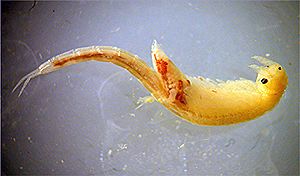Branchinecta lynchi facts for kids
Quick facts for kids Branchinecta lynchi |
|
|---|---|
 |
|
| Conservation status | |
| Scientific classification | |
| Kingdom: | |
| Phylum: | |
| Subphylum: | |
| Class: | |
| Order: |
Anostraca
|
| Family: |
Branchinectidae
|
| Genus: |
Branchinecta
|
| Species: |
B. lynchi
|
| Binomial name | |
| Branchinecta lynchi Eng, Belk & Eriksen, 1990
|
|
The vernal pool fairy shrimp (Branchinecta lynchi) is a tiny freshwater animal. It's a type of crustacean, like a small shrimp, and belongs to the family Branchinectidae. These special shrimp live only in Oregon and California, mostly in temporary ponds called vernal pools.
These fairy shrimp are quite small, usually growing to be about 11 to 25 mm long. That's less than an inch! The vernal pool fairy shrimp is considered a vulnerable species. This means it's at risk of disappearing if we don't protect its habitat. It has been listed as a Federally Threatened species since 1994.
Contents
What Do Vernal Pool Fairy Shrimp Look Like?
Vernal pool fairy shrimp are usually clear, or translucent, so you can almost see through them. Sometimes, though, they can be white or even orange!
They have special compound eyes that stick out on stalks. Unlike many other crustaceans, they don't have a hard outer shell called a carapace. They also have eleven pairs of legs. These legs help them swim by moving in a wave-like motion from front to back.
What Do They Eat and How Long Do They Live?
These tiny shrimp are filter feeders. They eat very small things floating in the water. Their diet includes algae, bacteria, protozoa, tiny animals called rotifers, and bits of dead plants and animals (which is called detritus).
Larger animals sometimes eat the fairy shrimp. Birds are common predators. Also, the tadpoles of spadefoot toads enjoy eating them.
Vernal pool fairy shrimp have a short life. They usually live for about two months. They often hatch in early January and then die in early March.
How Do They Survive Dry Periods?
Before the female fairy shrimp die, they lay special drought-resistant eggs. These eggs are very tough! They sink to the bottom of the vernal pools. When the pools dry up, the eggs stay buried in the soil.
Then, when the vernal pool fills with water again the next winter, the eggs hatch. This starts the whole life cycle over again. It's an amazing way for them to survive in places that dry out!
Where Do Vernal Pool Fairy Shrimp Live?
Vernal pool fairy shrimp have been found in specific areas. In southern Oregon, they live in vernal pools. They can survive if the water temperature is between 6 and 20 degrees Celsius (43 and 68 degrees Fahrenheit). In Oregon, you might find them in the Agate Desert, near Agate Lake, and on the Upper and Lower Table Rocks.
In California, these fairy shrimp have been found in many places. This includes 32 locations in the Central Valley, stretching from Shasta County down to Tulare County. They also live in the Coast Range, from Solano County to San Benito County. Other spots where they've been found include near Soda Lake, in Santa Barbara County, on the Santa Rosa Plateau, and in Riverside County.


